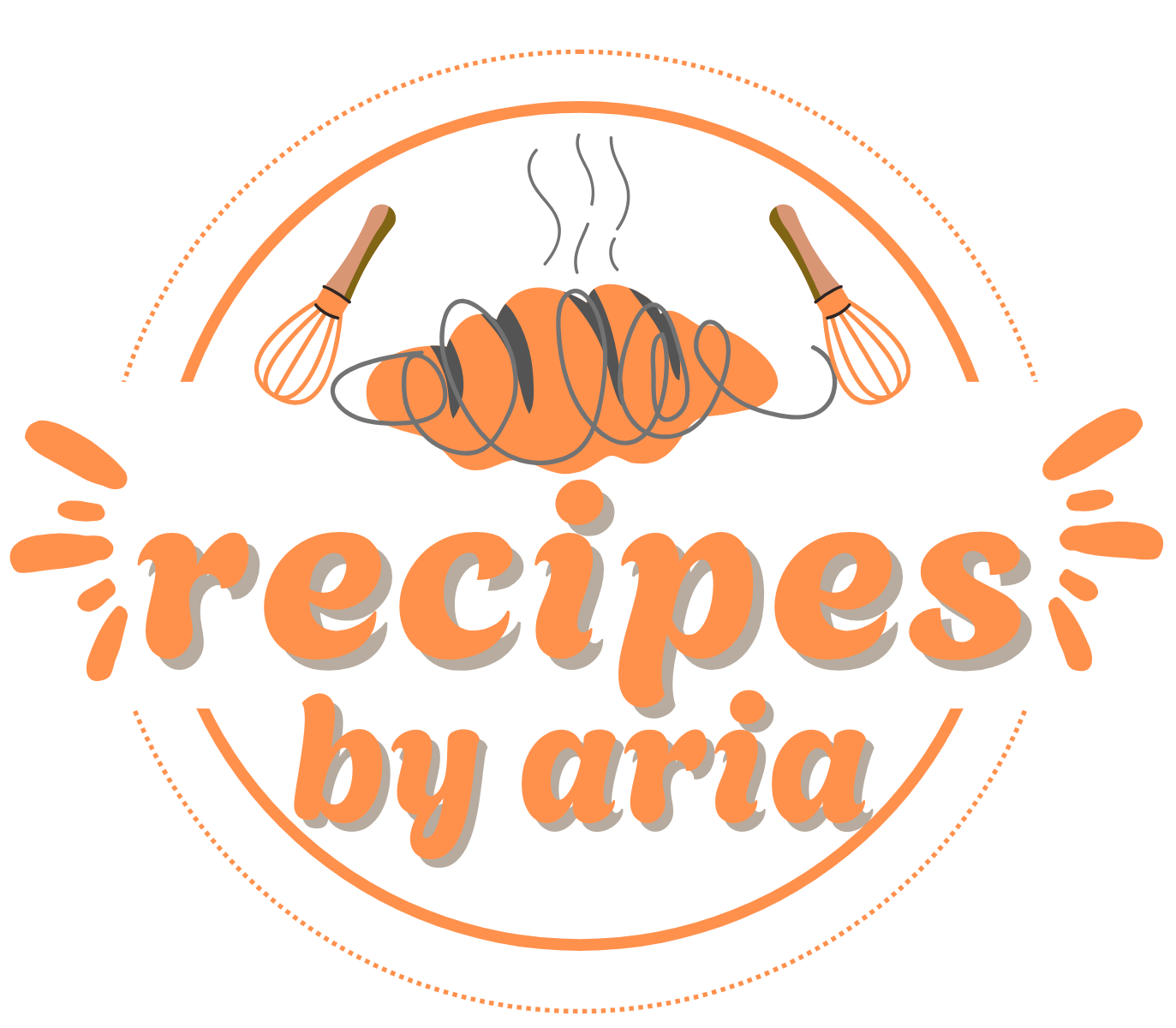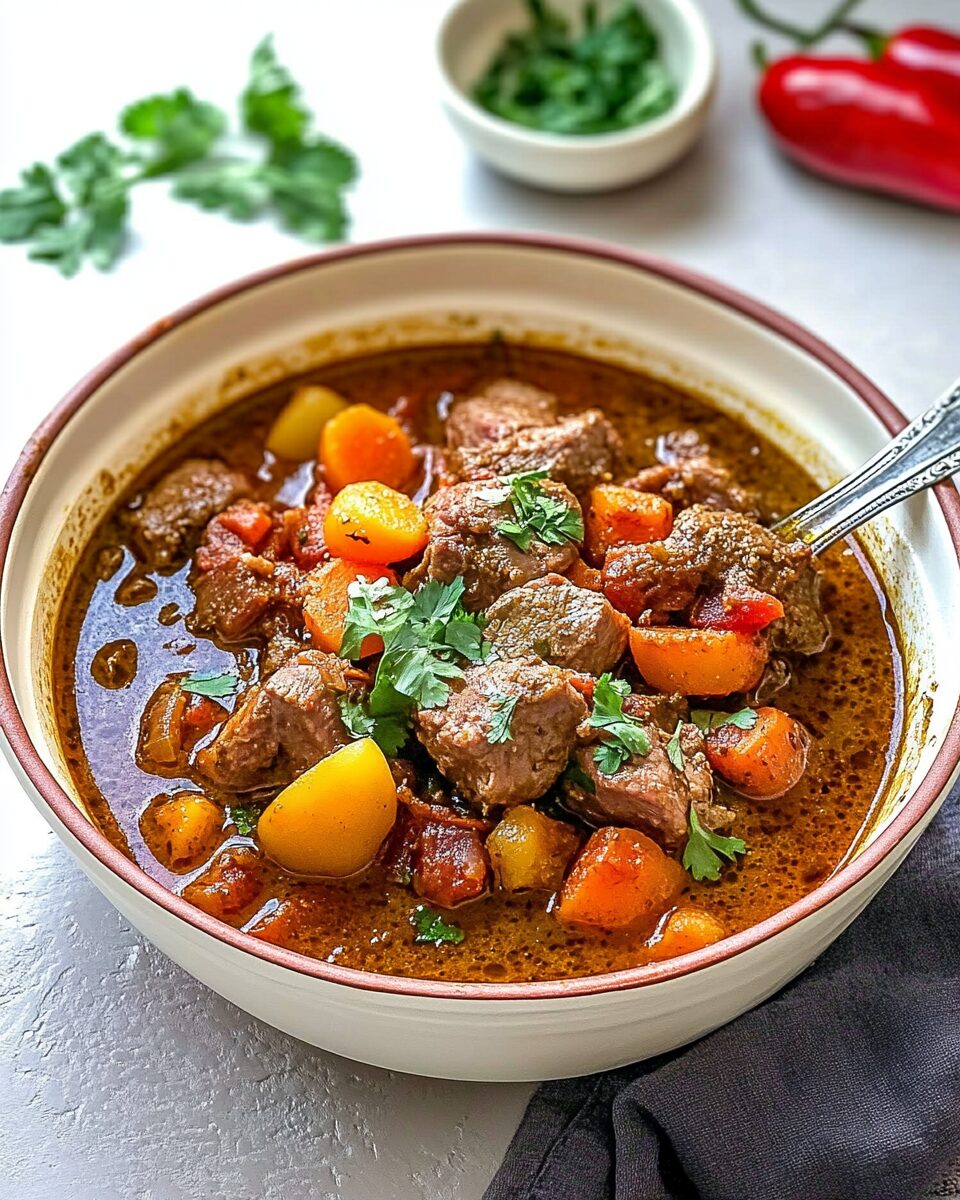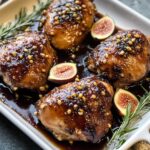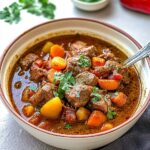The magic of this Moroccan Lamb Stew lies in its blend of spices cinnamon, cumin, and paprika that wrap tender chunks of lamb and soft root vegetables in a warm, aromatic embrace. A touch of sweetness from dried apricots balances the bold spices beautifully, creating a dish that’s both comforting and deeply flavorful.
Perfect for cozy nights or weekend gatherings, this stew is hearty enough to stand alone yet pairs wonderfully with couscous or warm bread. Let it simmer slowly to allow the flavors to mingle and the lamb to become meltingly tender. This dish is a celebration of bold, earthy ingredients and age-old cooking traditions.
Full Recipe:
Ingredients:
-
1½ lbs lamb shoulder, cut into chunks
-
1 tablespoon olive oil
-
1 large onion, chopped
-
4 garlic cloves, minced
-
1 teaspoon ground cumin
-
1 teaspoon ground cinnamon
-
1 teaspoon paprika
-
½ teaspoon ground turmeric
-
¼ teaspoon ground cayenne pepper (optional)
-
Salt and pepper, to taste
-
1 tablespoon tomato paste
-
4 cups beef broth
-
1 (14.5 oz) can diced tomatoes
-
2 large carrots, sliced
-
2 medium potatoes, peeled and diced
-
1½ cups butternut squash, cubed
-
½ cup dried apricots, chopped
-
Fresh cilantro or parsley for garnish
Directions:
-
In a large pot or Dutch oven, heat olive oil over medium-high heat. Brown the lamb in batches until golden on all sides. Set aside.
-
In the same pot, add onion and sauté until softened, about 5 minutes.
-
Add garlic, cumin, cinnamon, paprika, turmeric, cayenne (if using), salt, and pepper. Stir and cook for 1 minute until fragrant.
-
Stir in tomato paste and cook for 1 more minute.
-
Add beef broth and diced tomatoes. Bring to a simmer.
-
Return the lamb to the pot, then add carrots, potatoes, and squash.
-
Cover and simmer on low for 1½ to 2 hours, or until the lamb is tender.
-
Stir in dried apricots during the last 15 minutes of cooking.
-
Adjust seasoning to taste. Garnish with fresh herbs and serve hot.
Prep Time: 20 minutes | Cooking Time: 2 hours | Total Time: 2 hours 20 minutes
Kcal: 410 kcal | Servings: 6 servings
The Rich Tradition and Comfort of Moroccan Lamb Stew
Moroccan Lamb Stew is a dish steeped in history, flavor, and soul. At its heart, it’s a story of cultural fusion of spice routes that brought exotic flavors across deserts and seas, and of families gathering around tables to share slow-cooked meals infused with love and tradition. This stew is a perfect example of how simple, humble ingredients can be transformed into something deeply nourishing, both for the body and the spirit.
The Cultural Roots of Moroccan Cuisine
Moroccan cuisine is among the most celebrated in the world for its depth, balance, and complexity. It pulls from Berber, Arabic, Andalusian, and Mediterranean culinary traditions, each adding a unique layer of flavor and technique. The use of spices such as cumin, cinnamon, turmeric, and paprika speaks to Morocco’s historical position as a hub along the spice trade routes. These spices are not used to overwhelm, but rather to enhance and highlight the natural flavors of meats and vegetables.
In Moroccan cooking, stews (commonly referred to as “tagines” when cooked in the earthenware pots of the same name) are central. These dishes often include a protein lamb, chicken, or fish paired with a variety of vegetables, legumes, dried fruits, and an aromatic spice blend that simmers gently over time. It’s this patient, slow-cooking process that unlocks the full potential of the ingredients, resulting in tender meat and deeply flavorful broths.
The Allure of Lamb as a Stew Meat
Lamb is an especially popular meat in Moroccan cuisine, not just for its taste, but for its symbolic and cultural significance. It is considered a celebratory meat, often prepared for family gatherings, religious holidays, and communal feasts. In stew form, lamb transforms under low heat into succulent, fall-apart pieces that melt into the sauce and absorb the surrounding spices and aromatics.
Lamb shoulder is typically used in Moroccan Lamb Stew because of its marbled fat and connective tissue. As the stew simmers, these break down slowly, enriching the broth and contributing a luxurious texture that’s both hearty and satisfying. It’s a meat that embraces bold flavors, making it the perfect canvas for Morocco’s signature spice palette.
Spice and Balance: A Moroccan Art
The spices in Moroccan Lamb Stew are carefully chosen for their synergy. Ground cumin brings a nutty, earthy warmth. Cinnamon introduces a subtle sweetness and a touch of mystery. Turmeric adds depth and a golden hue, while paprika contributes a smoky note. For those who enjoy a gentle kick, a pinch of cayenne pepper adds fire without overpowering the dish.
But what makes Moroccan stews so remarkable isn’t just the heat or flavor it’s the balance. Many versions of Moroccan Lamb Stew incorporate sweet elements such as dried apricots or prunes. This unexpected touch of sweetness cuts through the richness of the lamb and the robustness of the spices, creating a harmonious, multi-dimensional dish. It’s a reminder of Morocco’s historic connections to both the East and the West where spices met fruits, and sweet met savory.
Root Vegetables: Hearty and Humble
In addition to the lamb, Moroccan stews often feature an abundance of seasonal root vegetables like carrots, potatoes, and squash. These not only provide color and texture but also soak up the stew’s spiced broth, becoming infused with its aromatic complexity. They make the dish more filling, more nutritious, and more vibrant.
Butternut squash, in particular, lends a creamy sweetness that plays beautifully against the spices and the savory lamb. Carrots bring a subtle earthiness, while potatoes offer comfort and bulk. Together, they form a rustic medley that turns this dish into a complete, well-rounded meal.
Cooking as Connection
One of the most beautiful aspects of making Moroccan Lamb Stew is the experience of cooking it. The process invites mindfulness: from chopping vegetables and measuring spices to watching the stew gently bubble and fill the kitchen with its rich aroma. This is not fast food it’s slow food, a labor of love that pays homage to centuries of tradition.
In Moroccan households, preparing a dish like this often involves the whole family. Elders share wisdom, children learn techniques, and everyone gathers to savor the final result. It’s not just about nourishment it’s about connection. And in today’s fast-paced world, that kind of meaningful cooking is more valuable than ever.
Serving Suggestions and Pairings
While Moroccan Lamb Stew is a satisfying dish on its own, it’s often served with accompaniments that elevate the meal. Traditional couscous, with its fluffy texture, is a classic pairing. It absorbs the stew’s juices and provides a light contrast to the richness of the lamb. Alternatively, crusty bread can be served on the side to mop up the flavorful broth.
A fresh herb garnish, such as chopped parsley or cilantro, adds a burst of color and a refreshing note that brightens the dish. Some also enjoy adding a spoonful of plain yogurt or a squeeze of lemon just before serving to enhance contrast and cut through the richness.
For drinks, a mint tea can cleanse the palate, while a light red wine, such as Pinot Noir or Grenache, complements the spice and lamb without overpowering the dish.
Nutritional Benefits
Beyond its comfort and flavor, Moroccan Lamb Stew is also a nutritionally balanced dish. Lamb is a rich source of high-quality protein, iron, and vitamin B12 important for energy, muscle repair, and immune health. The root vegetables provide dietary fiber, complex carbohydrates, and a range of vitamins and antioxidants. The inclusion of dried fruit adds natural sugars and minerals, making the dish both indulgent and beneficial for wellness.
Because it’s a one-pot meal, it simplifies both preparation and cleanup while delivering a nutritionally complete dish that satisfies multiple dietary needs.
Conclusion:
Moroccan Lamb Stew is more than just a recipe it’s a window into a world of rich culinary traditions and communal values. It’s a dish that invites you to slow down, savor, and appreciate the alchemy that occurs when simple ingredients meet time, patience, and care.
Whether you’re cooking it for a holiday meal, a dinner party, or a quiet night in, this stew is sure to impress. Its warmth and depth are comforting in colder months, yet its bold, bright flavors make it enjoyable year-round. Plus, it’s a versatile dish that welcomes personalization feel free to experiment with different vegetables, adjust the spice level, or use whatever dried fruits you have on hand.
In the end, what makes Moroccan Lamb Stew truly special is its ability to bring people together around the stove, around the table, and through a shared love of food that tells a story. Try it once, and it may just become a cherished favorite in your home.






